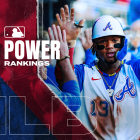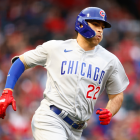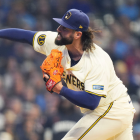Cubs starting pitcher Jake Arrieta will toe the slab Wednesday night in Pittsburgh in the Cubs’ first postseason game since 2008. He’s tasked with taking down a 98-win Pirates team that sends 19-game winner Gerrit Cole to the hill. If he can get the job done -- with help from his teammates, of course -- it would mark the first Cubs postseason win since Game 4 in the 2003 NLCS.
Needless to say, there will be plenty of talk about Arrieta during the game, and rightfully so. He just completed a Cy Young-quality season. He’ll finish in the top three. If he does beat out both Clayton Kershaw (likely) and Zack Greinke (totally a toss-up, I believe), it would be an amazing story, given his journey to becoming an ace-caliber hurler.
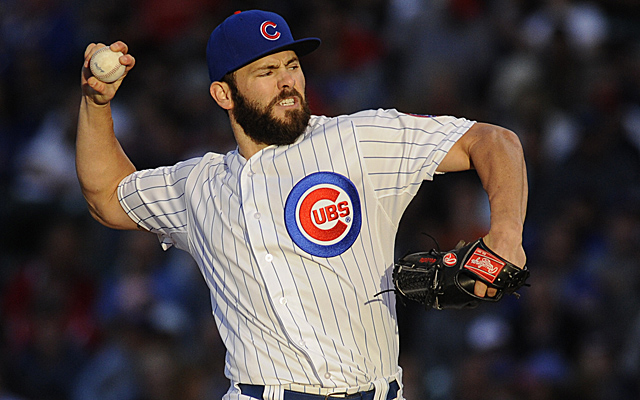
It’s the story of a youngster with great promise failing to meet expectations before being essentially discarded and then building himself into one of baseball’s best pitchers.
The journey
On July 2, 2013, the contending Orioles wanted to upgrade their rotation, so they acquired free-agent-to-be Scott Feldman from the Cubs, along with catcher Steve Clevenger. They sent back from international signing slots, reliever Pedro Strop and Arrieta.
At the time, here was the common sentiment from around baseball, as written by Danny Knobler of CBS Sports:
Feldman is the most proven player in a trade that also had Steve Clevenger going to the Orioles and international signing slots going to the Cubs. But Arrieta could end up being the best guy in the trade.
The emphasis there is on "could," because Arrieta is 27 years old and has yet to prove he can even stick in the big leagues. But scouts all agree that he has "top-of-the-rotation stuff."
The scouts have ended up being correct, though Arrieta needed both the change of scenery and to develop one of the funkiest pitches in baseball.
One of the several reasons that Arrieta fell out of favor in Baltimore was that the Orioles have an organization-wide policy to not allow pitchers to throw the cutter. Without it, he wasn’t nearly as effective. Some reports indicate they didn’t like much how he throws a bit across his body, too. They loved his upside, of course, as he was the 2012 Opening Day starter. He just couldn’t put it together with them, going 20-25 with a 5.46 ERA and 1.47 WHIP in his time there.
Working with Cubs pitching guru Chris Bosio certainly helped Arrieta, but there was something else. A soon-to-be unearthed weapon: the slutter.
Since coming to the Cubs, Arrieta worked on his cutter and made it into a hybrid that often looks different from pitch to pitch. He calls it a slider, but sometimes it looks exactly like a cutter. Sometimes it definitely looks like a traditional slider. This is what makes it so hard for opposing hitters to touch. It’s a combination pitch that never looks the same. It’s Jake Arrieta’s slutter.
Here’s one look:
See how that one resembles a slider with the drop and sideways movement? Now watch the second pitch in this montage:
That’s a cutter. But to Arrieta and his catchers, it’s the same pitch. It just has a different look depending upon how hard he cuts it.
Though the slutter is the difference-maker, it’s not Arrieta’s only effective pitch. He sits mid-90s with his heater while also mixing in a productive curve and change. In fact, down the stretch this year he’s started to use the curve more and more with great success. That different look only makes the slutter that much harder to pin down.
With this excellent stuff, Jake Arrieta, just 27 months after being discarded by one franchise, is enjoying the best season a pitcher has had in a Cubs uniform since the end of the Deadball Era.
Why are we excluding the Deadball Era? Because otherwise it’s not an apples-to-apples comparison. Prior to 1920, balls were left in play excessively. Pitchers could use a spitball legally and the ball could become doctored through the game without umpires saying anything. During the 1920s, spitballs became illegal and new baseballs were more routinely introduced into play. This, along with the rise of players taking more of a power-oriented approach at the plate a la Babe Ruth, helped to increase the offense from several of the most pitcher-friendly baseball seasons in history.
There was also a change in the baseballs. Via Baseball Reference:
Starting in 1919, baseballs were made with a higher grade of Australian wool yarn, with cores wound by machine rather than hand. Pitchers of the era were certain that the balls were springier and flew further off the bat than the old ones, but manufacturers denied the claims. One certain effect was that baseballs were cheaper to make, and thus easier to replace, to batters' benefit.
Basically, before these changes, the life of a pitcher was pretty darn easy compared to today’s standards.
The Cubs had one of the best, too. Mordecai “Three Finger” Brown’s average season from 1906-1910: 25-9, 1.42 ERA, 0.93 WHIP, 27 complete games, eight shutouts, 292 innings pitched. Again, that was an average of five seasons.
While Brown is a Hall of Famer, he wasn’t some gigantic outlier. He only led the league in ERA once during those five years. In 1907, his 1.39 ERA was only good for third in the NL, for example.
Basically, attempting to compare the Deadball Era to today’s game is a fool’s errand. There’s no reason to do so.
As we move onward, just keep in mind we’re only discussing baseball history beginning in 1920. Don’t worry, old-schoolers, because we’re gonna start by examining the oldest of old-school stats. The pitcher win.
The stats
Wins
The Cubs have had 26 seasons since the end of the Deadball Era from a starting pitcher in which he gathered at least 20 wins. Arrieta is in that group with a sparkling mark of 22-6. The only four pitchers with more wins in a season with the Cubs:
1. Pete Alexander, 27 in 1920
2. Charlie Root, 26 in 1927
3. Larry Jackson, 24 in 1964
3. Fergie Jenkins, 24 in 1971
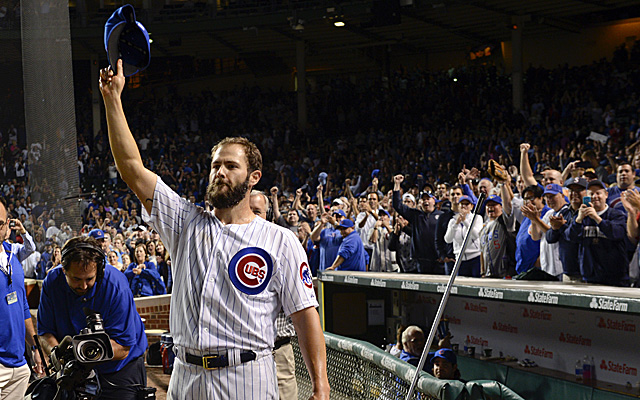
That’s it. It should go without saying, but we’ll again note the difference in eras because all of those guys started a lot more times than Arrieta did this season. Arrieta took the ball 33 times this year. Alexander started 40 games, Jenkins 39 and Jackson 38. Root started 36, but he also appeared in 12 games in relief.
To wit, Arrieta’s .786 winning percentage is tied for the best in franchise history among 20-game winners with Lon Warneke, who also went 22-6 back in 1932. From this lens, we can say Arrieta is tied for the best season in franchise history. As we go further and add more elements, Arrieta’s case strengthens.
Run prevention
How about ERA?
Among players who qualified for the ERA title, Arrieta is now one of only two Cubs in history with a sub-2.00 ERA. We once again see the Hall of Famer Alexander on the list, as he had a 1.91 ERA in his 1920 campaign. Warneke in 1933 had an ERA of exactly 2.00.
Arrieta this season posted a 1.77 ERA. Among pitchers who qualified for the ERA title since the end of the Deadball Era, only 16 pitchers have ever posted a better ERA in a single season.
Many old-school fans scoff at going further than traditional metrics, but there’s a problem with that. Let’s use Pedro Martinez vs. Three Finger Brown to illustrate.
In 1908, Brown had a 1.47 ERA. Pedro Martinez in 2000 posted a 1.74 ERA. Martinez was far better than Brown, though.
How is that possible? That’s easy. Look at the climate of the game in each respective year. Look at the average numbers in the leagues at the time:
1908 NL: 2.35 ERA, 3.3 runs per game, .239/.299/.306 triple slash line
2000 AL: 4.91 ERA, 5.3 runs per game, .276/.349/.443 triple slash line
Anyone acting like we should compare the raw numbers of those two seasons is out of his or her mind. Be real here.
This is where ERA+ is a helpful tool. It adjusts for league and ballpark conditions in each individual season. It starts with 100 being average and moves above or below based upon how much better or worse the pitcher’s ERA is compared to the rest of the league. So a 125 means the pitcher had an ERA that was 25 percent better than average and 75 means he was 25 percent worse than average. It should be real easy, so please don’t be that “too cool” guy who acts like it’s too complicated.
Anyway, Three Finger’s ERA+ in 1908 was 160. That’s outstanding. Sixty percent better than average? I’d take that in my job, as would most of the world.
Martinez, though, was nearly the best ever. In 2000, he posted a 291 ERA+, which is the highest in baseball history among qualifiers for the ERA title unless we go all the way back to 1880 for Tim Keefe’s 293.
So, yes, having a better ERA can actually be a worse season when we’re comparing different eras.
That’s important with us talking about Arrieta possibly having the best Cubs season ever. Though offense is a tick up this season from the past several pitcher-laden seasons, we’re not far removed from the most prolific offensive era in baseball history.
During this era, the Cubs had some pretty good individual pitchers. Before I searched, Mark Prior’s excellent 2003 season came to mind, just as Greg Maddux’s 1992 Cy Young season did. Let’s sort for ERA+ seasons of greater than 150 among qualifiers post-Deadball Era and see where it gets us.
We end up with 13, and guess who is on top?
1. Arrieta, 2015, 219 ERA+
2. Mark Prior, 2003, 179
3. Dick Ellsworth, 1963, 167
4. Greg Maddux, 1992, 166
5. Pete Alexander, 1920, 166
6. Lon Warnecke, 1933, 165
7. Bill Hands, 1969, 162
8. Carlos Zambrano, 2004, 160
9. Lon Warnecke, 1932, 160
10. Rick Reuschel, 1977, 158
11. Sheriff Blake, 1928, 157
12. Ryan Dempster, 2008, 154
13. Ray Prim, 1945, 153
That’s not particularly close, either. Arrieta is lapping the field in terms of run prevention compared to his peers.
Saying Arrieta was more than 50 percent better than Maddux in ‘92 and Alexander in ‘20 is simultaneously telling, impressive and laughable.
But he has been that much better. It’s ridiculous and true.
How? Well, missing bats and getting weak contact is how.
Arrieta is, not surprisingly, very adept at missing bats with the aforementioned four-pitch arsenal. The list of Cubs to ever average more than a strikeout per inning while logging at least 200 innings in a season is short.
1. Kerry Wood, 2003, 211 IP, 266 K (11.35 K/9)
2. Mark Prior, 2003, 211.1 IP, 245 K (10.43 K/9)
3. Matt Clement, 2002, 205 IP, 215 K (9.44 K/9)
4. Arrieta, 2015, 229 IP, 236 K (9.28 K/9)
5. Kerry Wood, 2002, 213.2 IP, 217 K (9.14 K/9)
6. Jeff Samardzija, 2013, 213.2 IP, 214 K (9.01 K/9)
It’s not only about the strikeouts, of course. Making guys miss is a huge part of pitching these days, but when the player gets the bat on the ball, what does he do with it?
Arrieta has allowed the fewest hits (5.9 H/9) and home runs (0.4 HR/9) per nine innings in the majors this season. Opposing batters own a .185/.236/.271 triple slash line against him. Basically, he has made the entire opposition look like a lineup full of pitchers. Good hitting pitchers, sure, but definitely pitchers because you know how many qualifying hitters this season have an OPS of less than .550? Zero.
How does this stack up against post-Deadball Cubs hurlers? Pretty great. The only other qualifying pitcher to hold the opposition to an average of below .200 was Kerry Wood in 1998 (.196). How about an OPS of less than .550?
1. Arrieta, 2015, .507 OPS against
2. Dick Ellsworth, 1963, .543
That’s it in the history of the Cubs franchise. Again, he’s lapping the field.
How about keeping guys off base? Arrieta boasts a WHIP of 0.865 this season. The list of qualifying Cubs pitchers to post a WHIP of below 1.00 (which is allowing an average of one baserunner per inning pitched) is again a short one.
1. Arrieta, 2015, 0.865
2. Warren Hacker, 1952, 0.946
3. Dennis Eckersley, 1985, 0.969
4. Bill Hands, 1968, 0.994
5. Ray Prim, 1945, 0.998
Yep, first again. It’s not close, either. Again.
Wins Above Replacement
And here we go. I can hear the screams through my computer screen. Wins Above Replacement (WAR) is so polarizing, but it can be useful as a quick-and-dirty comparison between seasons. No one with a brain claims it’s the be-all, end-all stat (this doesn’t stop opposers from using this strawman argument, but that’s a different discussion for a different day).
One fallacy is that no one knows what goes into it. If you want to know, Baseball Reference explains the formula. If not, don’t say no one knows what goes into it, please. You’ve been given the explanation.
Anyway, one thing to keep in mind is this is a cumulative stat. So any pitcher working at a high level will gain more with the more innings he pitches. That’s going to put Arrieta at a disadvantage against those pitchers from the eras where they regularly completed games and started upwards of 42 games thanks to four-man (or fewer) rotations.
And still, he’s right there. Here are the pitchers with more than 8.0 WAR in a season for the Cubs, post-Deadball era.
1. Pete Alexander, 1920, 12.1
2. Fergie Jenkins, 1971, 10.3
3. Dick Ellsworth, 1963, 10.2
4. Rick Reuschel, 1977, 9.4
5. Greg Maddux, 1992, 9.2
6. Arrieta, 2015, 8.6
7. Bill Hands, 1969, 8.4
Alexander worked 363.1 innings, by the way. Jenkins went 325 and Hands worked 300. Even Maddux in 1992 managed 268. Basically, the innings pitched are the separation here with Arrieta being held to 229 in 33 starts.
One of best second halves in MLB history
What Jake Arrieta has done since the All-Star break is so astounding that we can quit comparing him just to other Cubs in history. We can go with all of baseball.
We could even go back further, as Arrieta is 16-1 with a 0.86 ERA in his last 20 starts. The Cubs won 18 of those 20 starts. Arrieta’s only loss was Cole Hamels’ no-hitter. The no-decision loss came thanks to the bullpen blowing a save against the Cardinals.
Still, we need to use the All-Star break as the cut-off here for purposes of tidy historical comparison.
In the second half, Arrieta is 12-1 with a 0.75 ERA, 0.73 WHIP and 113 strikeouts.
A list of the pitchers in MLB history (again, post Deadball Era) with a sub-1.00 ERA in the second half, among pitchers who made at least 10 second-half starts:
1. Jake Arrieta, 2015, 0.75
2. Kris Medlen, 2012, 0.92 (as a starter only)
3. Roger Clemens, 1990, 0.97
That’s it. We’ve got Arrieta, a pitcher who switched to being a starting pitcher for the last two months and caught lightning in a bottle and one of the greatest pitchers of all time. That’s our threesome here. For those wondering, Bob Gibson’s second-half ERA in 1968 was 1.19.
Throw in Arrieta's no-hitter in Los Angeles against a playoff team and this is just piling on.
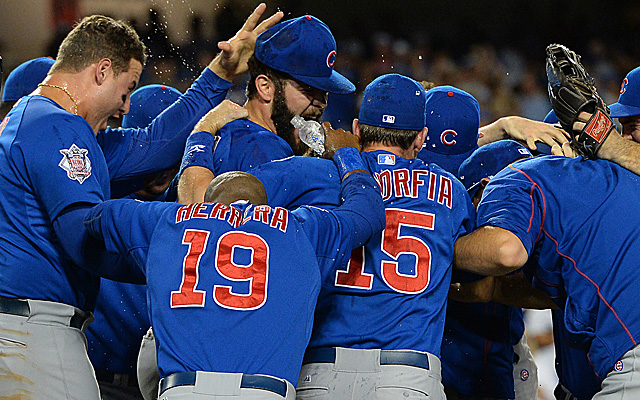
When was the last time Arrieta had a "bad" start? We have to go back to the first half.
Arrieta allowed more than three runs in a start four times this season, and all four came prior to June 17. All four times, he allowed four earned runs, never more.
Arrieta's last bad outing, which is surely what the Pirates will be hoping to duplicate, came on June 16 against Cleveland in Wrigley Field. His command was off, as he walked six while only allowing three hits in five innings. The result was a 6-0 Cubs loss. With Arrieta, he was so inefficient he needed 112 pitches just to get through his five innings.
He followed that up with a shutout in Minnesota and never looked back. He hasn't walked more than three in a game since and hasn't ever failed to complete six innings. He hasn't allowed more than three runs in a start, either, meaning he's got a string of 20 quality starts running.
The Cubs' ace rides a 22-inning scoreless streak into his first-ever postseason start.
Quite simply, Jake Arrieta -- who a contender had no use for two years ago -- is now having the best season any Cubs pitcher has ever had and the best second half anyone has ever had. What an amazing game baseball can be.
Enjoy it and embrace it, non-Orioles fans. OK, and non-Pirates fans, too, heading into what looks like an excellent NL Wild Card matchup.













